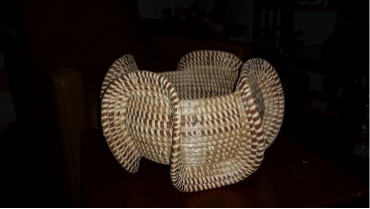

Alma Washington
31.0 x 30.0 x 18.5 cm
(centimeters)
12.2 x 12.0 x 7.3 in
(inches)
This basket was made by Alma Washington, an African American and Gullah/Geechee artist. Her basket represents a long tradition of basketry from the Sea Islands of the Carolina and Georgia coast. The basket is made from woven coils of dried sweetgrass that spiral upward from base to lip. Darker pine needles add visual contrast. The rising and falling pattern of the handles and feet are characteristic of the wave basket type. Gullah/Geechee baskets are commonly sold in South Carolina, on a stretch of Highway 17 between Charleston and Mt. Pleasant.
Basketmaking is widespread in the rice-growing region of Africa from the Senegambia to Liberia. White Carolina and Georgia Lowcountry planters in the British Colonies and later United States took Africans skilled in rice growing from this part of West Africa, and the captives in turn brought with them a wide array of basketmaking techniques. In the Lowcountry, these peoples adapted their skills to local materials and created new basket styles. Although the baskets themselves have changed from their African precedents, basketmaking has been a common feature of life in the Low country for more than two centuries.
Sweetgrass baskets have been a key symbol around which Gullah/Geechee group identity has formed. As outsiders recognized the baskets as distinctive merchants, academics and others suggested the art of their manufacture was an Africanism that had survived in the Sea Islands due to the area’s relative isolation. Scholars have suggested that the name “Gullah” is derived from Angola, or from the Gola people of Liberia, for instance. Nevertheless, evidence shows that the same waterways that separate the islands from the mainland also allowed boats to travel up and down the rivers, and thus allowed baskets and weaving traditions to move with them. Nevertheless, the recognition of Africanness in the baskets has generated a new surge of interaction between the region’s African Americans and people in West Africa.